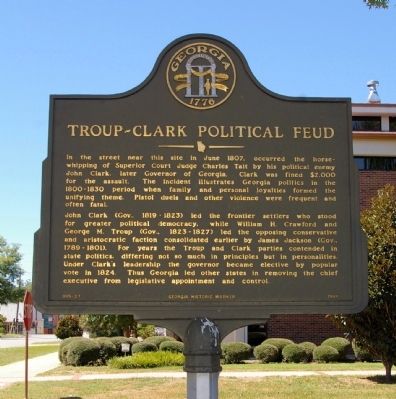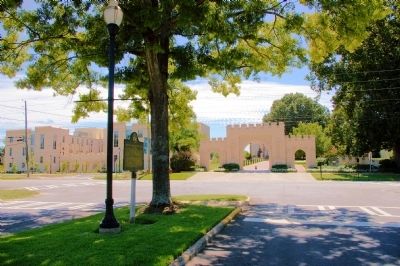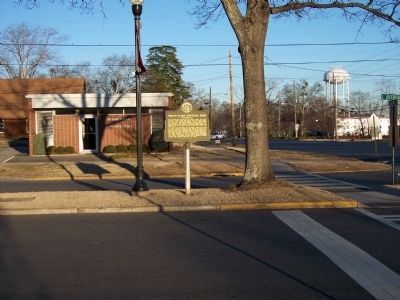Milledgeville in Baldwin County, Georgia — The American South (South Atlantic)
Troup-Clark Political Feud
John Clark (Gov., 1819-1823) led the frontier settlers who stood for greater political democracy, while William H. Crawford and George M. Troup (Gov., 1823-1827) led the opposing conservative and aristocratic faction consolidated earlier by James Jackson (Gov., 1789-1801). For years the Troup and Clark parties contended in state politics, differing not so much in principles but in personalities. Under Clark’s leadership the governor became elective by popular vote in 1824. Thus Georgia led other states in removing the chief executive from legislative appointment and control.
Erected 1989 by Georgia Department of Natural Resources. (Marker Number 005-27.)
Topics and series. This historical marker is listed in this topic list: Government & Politics. In addition, it is included in the Georgia Historical Society series list. A significant historical month for this entry is June 1807.
Location. 33° 4.819′ N, 83° 13.503′ W. Marker is in Milledgeville, Georgia, in Baldwin County. Marker is at the intersection of East Greene Street and South Jefferson Street, on the left when traveling east on East Greene Street. Touch for map. Marker is in this post office area: Milledgeville GA 31061, United States of America. Touch for directions.
Other nearby markers. At least 8 other markers are within walking distance of this marker. Milledgeville Confederate Monument (here, next to this marker); Georgia's Secession Convention (within shouting distance of this marker); State House Square (within shouting distance of this marker); Alexis de Tocqueville (within shouting distance of this marker); In Commemoration of Marquis De Lafayette (within shouting distance of this marker); Old State Capitol (about 400 feet away, measured in a direct line); Site of Fort Defiance (about 400 feet away); Statehouse Square (about 500 feet away). Touch for a list and map of all markers in Milledgeville.
More about this marker. This marker replaced an earlier marker of the same title and text, erected by the Georgia Historical Commission at this location.
Credits. This page was last revised on June 16, 2016. It was originally submitted on October 1, 2010, by David Seibert of Sandy Springs, Georgia. This page has been viewed 1,197 times since then and 64 times this year. Photos: 1, 2. submitted on October 1, 2010, by David Seibert of Sandy Springs, Georgia. 3. submitted on January 27, 2011, by Michael Dover of Ellerslie, Georgia. • Craig Swain was the editor who published this page.


